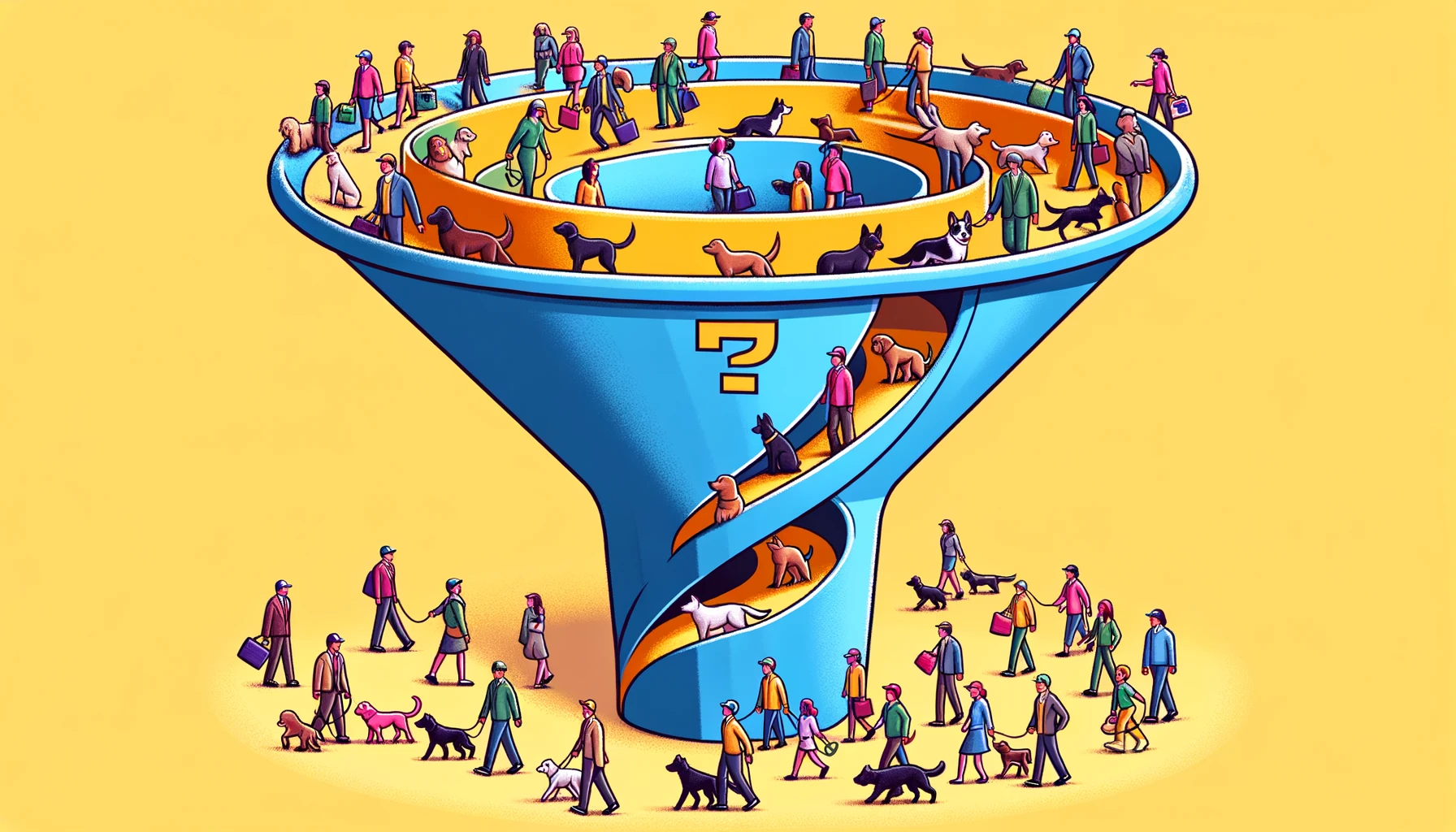It’s not news to anyone on the front lines of the rescue, trainer, or breeder communities: we’re struggling with a pervasive owner education problem. Despite having the best intentions for their dog, many owners have significant gaps in core, foundational knowledge on how to appropriately handle, raise, care for, and communicate with their puppy or adult dog in a manner that is healthy, sustainable, and effective. Those knowledge gaps – which many owners aren’t even aware they have – not only make their and their dog’s lives and relationships more stressful and less fulfilling, they are also producing serious, negative, and avoidable outcomes on a tremendous scale.
Anecdotally, trainers see it every single day; a dog:
- Tearing up the house because she’s not getting enough activity or mental stimulation
- Developing reactivity from being thrust into dog parks stressed and terrified without their owner understanding the risks or recognizing that body language
- Barking all day because she’s left alone without any preparation or conditioning for separation anxiety and/or without her foundational needs being met
- Ignoring important handler cues because she either doesn’t know what they mean or they’ve been used too inconsistently
- Jumping on visitors because it’s unintentionally reinforced with attention
- Biting at kids out of stress because she’s never been carefully socialized to children, and the children are allowed to engage with her in the unpredictable, erratic, forward way that kids too
On and on, every day in every house and community, we see otherwise well-meaning owners unwittingly engaging in behavior that leads to poor outcomes ranging from stressful nuisances and anxious, under-enriched dogs to serious reactivity, safety risks, and life-long barriers to a good quality of life for both dog and guardian. At the same time, owners are missing out on the opportunity for the far more profound, intimate relationship with their dog that comes from mutual comprehension.
The particular tragedy of these instances of mis-handling is how avoidable they are: with just a bit more understanding of how to think about and appropriately interact with their dogs, more owners would be living better, easier, less stressful, more fulfilling lives with their dogs.
So where is this problem coming from? Why isn’t the average owner more knowledgeable, when they benefit more than anyone? It’s certainly not for any lack of resources: there are tons of fantastic educational resources out there – books, classes, videos, online courses, private trainers, etc. – every sort of media, at every level of experience, time commitment, and expense.
Over the past three years we have interviewed hundreds of owners to better understand what is going on. We have found that the issue stems, at least in part, from a ‘pipeline problem’:
- First, many owners don’t know what they don’t know. They don’t realize how significant their gaps in knowledge are – or appreciate its consequences (farther below, we’ll talk about why this may be happening).
- Then, as a result, despite the abundance of fantastic resources out there, many owners never truly start their learning journey.
In 2013, Stepita et al.[1] found that as few as 5% of puppy owners in the US may take a class or work with a trainer. That finding is seemingly verified by the annual APPA National Pet Owners Surveys in 2022 (5%) and 2023 (6%). Even if those were gross underestimates, it seems we can be confident that well over half of dog owners – equivalent to 40+ million dogs – never take a class.
In other words, we’ve built a fantastic educational pipeline – from puppy books and basic obedience classes to private training, the CGC, and dog sports – but we aren’t getting enough owners into that pipeline. Not enough owners are starting their educational journey.
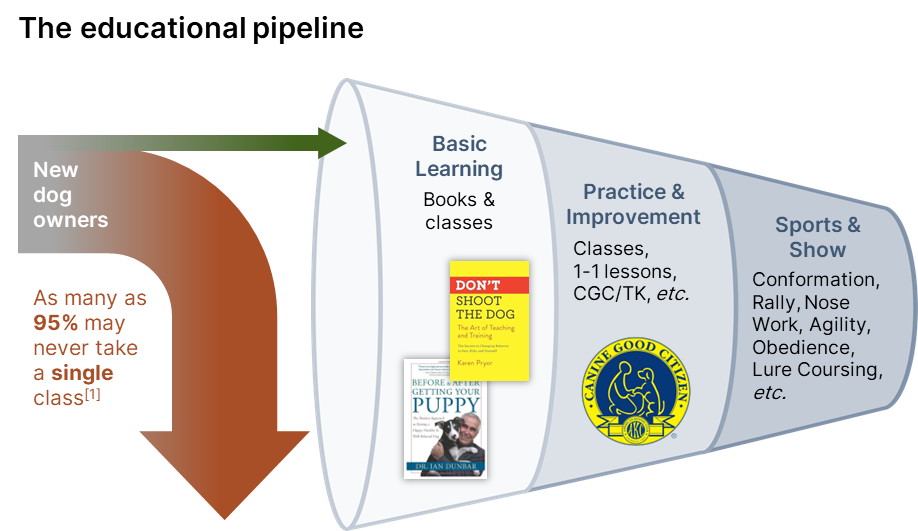
We can see all of this play out in the data. In this first figure, we can see that yes, indeed, dog ownership is exploding:

Note that trend is pre-pandemic, even before the ‘covid puppy’ boom. Since 2001, the number of dogs in the US has increased by nearly 40%, more than twice as fast as population growth. Per The Economist, there are now more households in the US with dogs than with children.
On top of that, owners also care more than ever about their dogs:
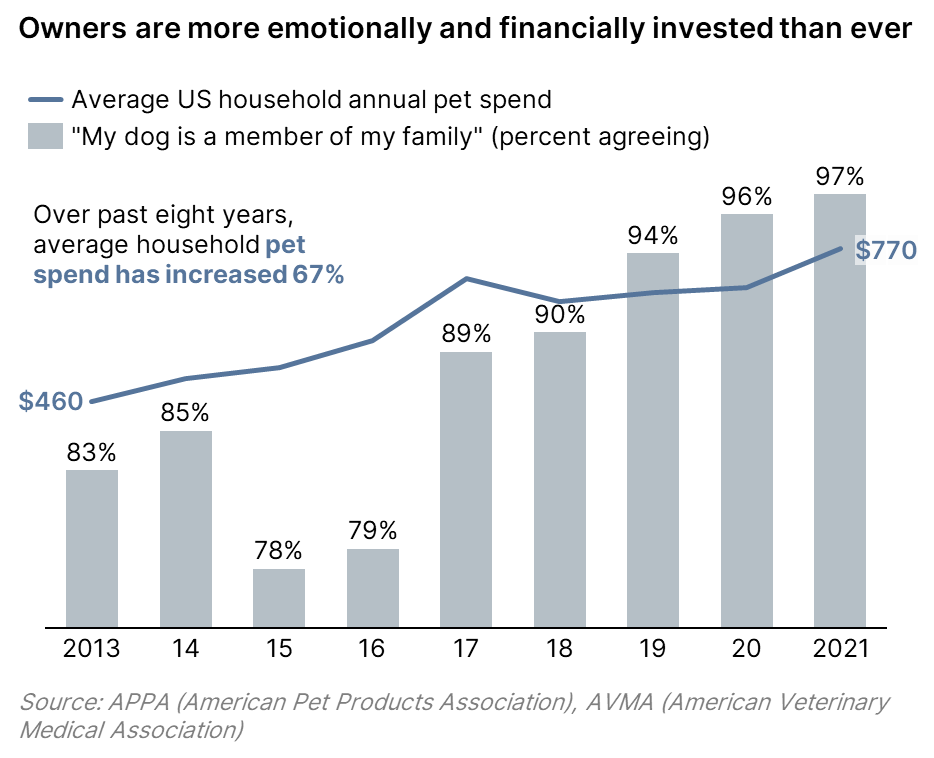
Again, the data reflects what we see anecdotally: as people increasingly delay or forego childbearing, not only are more of them getting dogs, they are also committing more emotional and financial energy to them. Our relationship with dogs is changing – we increasingly see them as profound personal relationships, as members of our family.
Now, however, let’s look farther down the pipeline, at the number of new people entering dog sports:
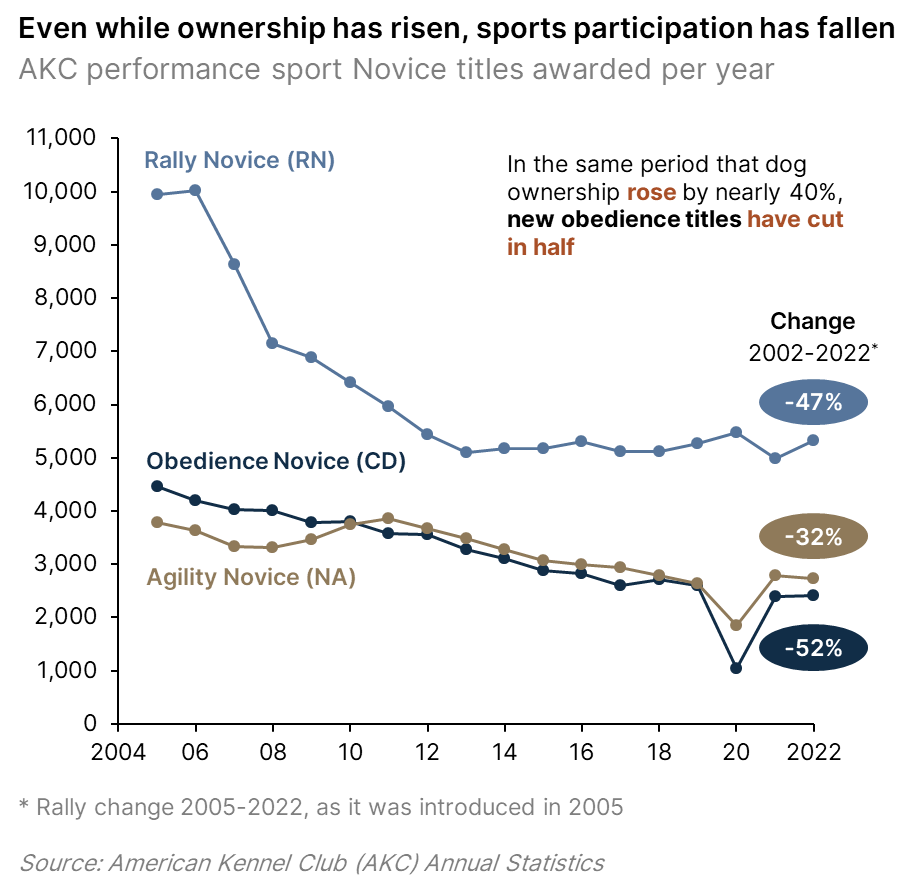
Think about that: in the same period that dog ownership has risen by nearly 40%, new entrants in competition obedience have fallen by over half![2] In 2002 around 5,000 dogs earned AKC Novice Obedience titles; by 2022 that number fell to around 2,400 – that’s a staggering decline, especially given that the actual number of dogs in the US increased substantially in that period.
Of course, dog sports aren’t really the point of what we’re talking about; you can be a responsible, competent handler without doing sports. Rather, if we think back to that pipeline, sports are downstream. Dog sports competitors start as folks in their first Basic Obedience class, who then go on to the CGC, and then try out Agility or Rally etc., and finally get hooked from there. Seeing a decline this substantial in novice sports participation is just another data point supporting the broader observation that we may not be getting enough owners into the educational system upstream.
We see this in other snapshots too. Consider publication data: the most popular, accessible introductory books in the world – the likes of Dunbar’s Before & After Getting A Puppy, Pryor’s Don’t Shoot the Dog, or the Monks of New Skete’s How to Be Your Dog’s Best Friend – are considered massively successful to sell a few hundred thousand copies over many years, as compared to a total population of well over 60 million dog owners, including several million brand new owners every year.
Therein lies the pipeline problem: more of us own dogs, and spend more time, energy, and money our dogs, than ever before – and yet fewer and fewer of us seem to be going down the ‘pipeline’ of books and classes that then lead some portion of us into better handling and more activities.
So why is this all happening? Why don’t dog owners realize their gaps in knowledge, and seek the resources that would alleviate it?
Our ethnographic interviews consistently suggest that, at root, we have a cultural issue. Most owners think “If I want a dog, I go to the shelter, get a dog, take it home, and take care of it.” Nowhere in that sequence is the idea that you need to actually learn how to handle, care for, train, or communicate with a dog. Culturally, in how dogs are portrayed in media, in how we talk about them and perceive them, the average person just doesn’t think of dog handling as a skill that needs to be learned. It’s silly really: if you want to sail, you obviously need to learn how to sail; if you want to take up woodworking, cure meats, or go skiing you obviously need to learn how; and yet if you want to handle a dog, we somehow think no learning is required. And so despite the best of intentions, despite a major emotional and financial commitment, owners are often grossly unprepared, without even realizing it.
In other words, we have, in part at least, an awareness problem; most owners don’t realize:
- That appropriate dog handling requires some knowledge and preparation
- That they have serious (but easily remedied) gaps in knowledge
- Or that those gaps in knowledge can have serious consequences for them and their dog
At a macro level, this education problem is at least contributing to poor outcomes for dogs on a truly massive scale: in the US today, roughly 1 in 3 dogs is given up for adoption, 1 in 10 adopted dogs is returned to the shelter, and 1 in 18 dogs is euthanized.[3]
How do we close this gap? How do we get more owners into the fantastic educational pipeline we as a community have built? Some of our more recent work (see article) suggests that while there is a wonderful educational ecosystem out there, we need more tools that are tailored to realities of the average owner’s life and mentality, and designed to get more owners into the ‘educational funnel.’ As an example, that is why we created and how we designed the Good Owners Guide to Dogs. On the whole, we are optimistic; while the challenge of raising the bar, systematically, in dog owner education is daunting, it also presents an opportunity: there are millions of owners every month searching for desperately for information and answers, if we as a community can find innovative ways to intercept and guide those desperate owners towards the high quality resources out there, we can have a tremendous positive impact on the lives of millions of dogs.
[1] Stepita, ME; Bain, MJ; Kass, PH; Journal of the American Animal Hospitalization Association 2013
[2] That figure might surprise some: total ‘participation’ in dog sports, as in the total number of trial-entrances per year (so 1 dog that goes to 10 trials would be 10 trial-entrances), has risen in this period, even as the number of Novice titles has fallen. That seems to be a reflection of an increase in the number of titles: there appear to be fewer unique dogs trialing, but each dog is going to far more trials.
Another question in a reader’s mind might be: “is this a real decline, or are new owners just being cannibalized from rally, obedience, and agility to other, growing sports like scent work and protection sports?” While that intuition is sound, the broader data suggests that migration to other sports is insufficient to explain the bulk of this decline, for several reasons: (a) this trend predates the bulk of those sports (NACSW scent work, for example, was only introduced in 2009, and only gained appreciable traction in the early 2010s); (b) the total population in those sports is smaller than this decline, and doubly so when overlap is considered; and (c) the trends above are secular, linear, and consistent over the full 20-year period, if it were a cannibalization effect you would expect more nonlinear steps as new competing sports are introduced.
Ideally, a more granular examination of the data, looking at individual-dog data (rather than titles, since one dog can compete in multiple sports), across more sports would address those questions more thoroughly. For the time being, however, the available data seems to suggest a clear and longitudinal net decline in the number of new owners entering dog sports.
[3] Based on ASPCA 2019 adoption estimates versus total annual dog population; at least 47% of these are specifically for behavioral issues; and Hoffman, CL; Thibault, M; Hong J; Frontiers in Veterinary Science 8, 2021
